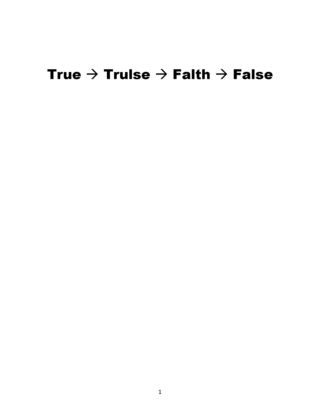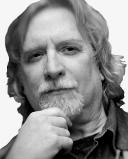Deception
False Is the New True—Part 2
Is the lying that pollutes our lives different now?
Posted August 8, 2017

The great American film, Fargo, by Joel and Ethan Coen (1996) begins with a few words to the viewer:
"This is a true story. The events depicted in this film took place in Minnesota in 1987. At the request of the survivors, the names have been changed. Out of respect for the dead, the rest has been told exactly as it occurred."
There are many dark and weird and weirdly dark things that go on in the movie. As the movie develops, the viewer periodically thinks “This is TRUE?? – Holy Hamburgers!! — Yet, I can definitely see people actually doing this!” This is the exact movie experience the Coen brothers wanted.
The juicy “this is true” enticement is utterly false. The Coens finally said so, more or less, and coyly, over a period of two decades. It is now known that the “true story” claim was the Coen brothers way of getting the viewer into the place they wanted him or her. The story is true only in that events similar to some of those in the movie do happen in real life (people do get murdered for money). In 2015, Joel said that “the only thing true about it is that it’s a story.”
Fargo is famous — even legendary. But it is not a true story, even though it said it was. Hence, its lie has some force behind it (of course, in this case, it is not clear the lie was malicious, but it is still a lie and the viewers were played). So now, when you make your own movie based on the real events in your life, and you say “Based on real events,” no one will believe you: 'The Coen Brothers already did this, and we shouldn’t have believed them.'
As we all know, Truth seems to have been demoted lately. Here in the early 21st century, lying is as common as breathing. Governmental lies, told wantonly, pollute our lives. Lies about science, global warming, evolution, sex, gender identity, the military, voter fraud, vaccines, police shootings, guns, and gun safety are crammed down our throats. Our elected officials lie to us about their personal behavior and finances. Facebook, Twitter, and tens of millions of web pages contain vast quantities of lies. Some actual humans report that if a bit of information is found on social media, their default is to assume it is false.
Please note: your fellow humans are not making mistakes — they are lying to you. They are deliberately telling you something they either explicitly know to be false or something they don’t know to be true (see the case about the British PM David Cameron having sex with a dead pig head in The Guardian reference below). This second case — reporting willy-nilly — happens usually because the liars desperately want what they say to be true, or because they don't care whether it is true or not. Some people, like trolls, just shoot from hip, making up stuff as they type. But others, in the current governments of the world, plan and plot their lies, working hard over decades to get their lies accepted as “common knowledge.” Examples in the U.S. include the lies about the prevalence of voter fraud, the usefulness of owning a gun, the deadly consequences of marijuana, the abuse of social welfare programs, the laziness of the under- or unemployed, and the power of socialism to destroy America. All of these are huge lies forced on us by our government and, unhappily, believed by millions.
How did this happen? How did false become the new true? We saw a part of the answer in Part 1 of this series, last month: taking diversity seriously (different people think different things are true), the over-reaction to this diversity by the postmodern philosophers, and finally, the diseases of Relativism and Manipulation. Truth became what someone wants others to believe. But another, deeper part of the answer to the question “How did false become the new true?” is that it didn’t: The False has always been the True.
A brief check with human history shows that Truth has always been tortured to force it to cry out that it is false. Egyptian pharaohs claimed to be descended from gods. (Of course, this lie was a common practice of “nobility” long before the pharaohs.) Flood stories abounded, but there was no worldwide flood and no Noah’s ark, and everybody knew it. Lies killed Socrates. The ancient Greeks lied to end their decade long war with the Trojans by building a large wooden horse and claiming it was a peace offering (I think we all like this one and agree it was pretty clever). The rise of the Catholic Church from the death of Jesus to the Council of Nicaea (325 CE) was crawling with lies on both sides as the Church struggled to consolidate power over the hundreds of other versions of Christianity that were all competing for adherents. Continuing, the Catholic Church lied about the Holy Land and the “threat” from Muslims. The Church lied about witchcraft, about who was a witch, and why. (To see the depths to which these particular lies sunk, see God's Jury: The Inquisition and the Making of the Modern World, by Cullen Murphy, Houghton, Mifflin, & Harcourt). And, continuing to today, the Church lied to us about its pedophilic priests, with disastrous consequences. (Religions are incubators of lies because they form a safe space for con artists, who are liars by trade, as well as those who lie to themselves — the self-deceived.) All wars have been, if not started by lies, at least fueled by them (“the enemy is something non-human which will destroy all of us”). Scientists also lie (though science doesn’t). Piltdown Man was a dark scientific hoax started in 1912 in England. One Charles Dawson claimed to have found the skull of “the missing link” between humans and apes. The fraud was only exposed in 1953 after it came to light that the skull was a skillful combination of the mandible of an orangutan and the cranium of a human. Marc Hauser, former Harvard psychologist, lied about his research on non-human primates (in 2011, he was barred from teaching in any Arts and Science department at Harvard). And, telling one of the darkest lies ever, Andrew Wakefield, a one-time British medical researcher, fabricated data to support his scam that vaccines cause austism — because of Wakefield’s lies, many children died. Last, but not least, our students are no longer hungry for the truth (this hunger really did characterize the ’60s); they are now hungry for the false — and American universities are happy to comply. And on and on. . . . Lies, betrayals, deceits, fabrications, pretenses, etc. power our long history, our culture, and our daily lives.
So humans have always had a love-hate relation with truth. Our needs, wants, desires, triumph over the truth at almost every turn. The truth is only embraced when it is what we wanted anyway. Yes, there are more lies now, but there are more people now. And of course, we must not forget the Internet, which somehow stokes our lies. See, for example, this good article in The Guardian. But the current blizzard of lies, especially in the U.S., is really just business as usual.
. . . Except for this: We were making such good progress. Science was flourishing. Science was respected. Even Bush-appointed judges were openly siding with science, as in Kitzmiller v. Dover Area School District, where “intelligent design” (aka, creationism) was required teaching in public schools, until judge John E. Jones III threw that out for violating the First Amendment of the United States. Open investigations were becoming the norm, or at least expected. Lies began having a shorter shelf life (the Watergate lies told by the Nixon administration only lasted only a few hours — though it is true that the full extent of these lies wasn’t revealed for years). The lies of large corporations were exposed: Big tobacco was exposed as a dark conglomerate lying about the dangers of smoking; Johns Manville’s lies about asbestos were revealed; automobile companies were forced to do recalls. . . . Oh, the future really did look bright! Yes, there would still be lies, yes there would still be very big, deadly lies. But there was reasonable hope that these might be exposed quickly and forcefully, and then fixed. And perhaps it was not too much to hope that lying itself might diminish some.
But then something happened. And lies came back . . . with a vengeance — replacing truth with falsity. I don’t know what happened. But all the great gains Truth & Science made have slipped away. There are many events one might chose as the progenitor of this decline of science and truth: (1) George W. Bush’s war based on the 'existence' of nonexistent weapons of mass destruction, which weapons inspectors insisted Iraq no longer had (and the inspectors were right), (2) the denial of global warming — a global phenomenon that anyone can see, (3) the election of Donald Trump. There are several other candidate events, including the rise of social media, and possibly, the release of Fargo.
(For my part, I regard the election of Mr. Trump as a cause of the decline of truth, rather than the decline’s cause.)
It seems as if our desires for “the good ol’ days of yesteryear” trumps the truth. And one of the greatest casualties of this is the expulsion of science from governmental decision-making and public discourse.
How do we get truth back? By fighting for it. And in a sign of continued hope, fighting for the truth is also old — as old as our hatred and suppression of it.




